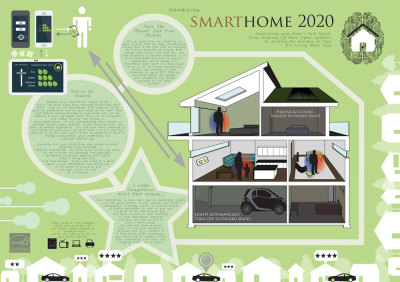
STORY BY MEHREEN SHAHID
Sheridan students envision houses in 2020 to be built using automated systems, remote monitoring and a sense of neighbourly competition to help conserve energy and promote green practices.
“If it is known to you that other people in your community are obtaining this level of efficiency, it would make you want to do well,” said Harleen Pabla, a third-year Architectural Technology student.
Pabla, with her colleague Mario DeSantis, entered a competition sponsored by WORKshop Inc. in Toronto, a centre for ideas and design innovation. Beginning in August, students from all over Ontario submitted a house plan designed for the year 2020.
“Our idea was based upon integrating technology more and more into the house,” said DeSantis, 22. The two students propose using technology to study electricity, water and gas consumption and general living patterns of residents. Based on the data collected, suggested changes in consumption can lead to savings.
The design proposes using heat and motion sensors that will turn off lights and lower heat or air conditioning in unoccupied rooms. Residents will also be monitored for changes in physical health. If a senior occupant has a medical emergency, the system will send out a message to their emergency contact.
MORE RELATED TO THIS STORY:
- Home Safe by Laura Sky takes us through the lives of the homeless
- Faculty builds better lives for families
- Single mom goes from eviction to election bid
Unique to their design is the use of competitiveness to encourage neighbours to go green with a vengeance, Pabla said.
“Each house has a rating based on how much energy you have conserved at the end of the day,” she said, and competition pushes people to beat the best scores. “We could use that and social media to make communities better.”
Christopher Ferguson, professor and co-ordinator for the Architectural Technology program, said design competitions such as this help take students’ minds off grades.
“When you’re graded, a lot of students just tend to regurgitate,” he said. “But when you get in a competition, the thought process is different. There is a much freer aspect to what the final solution might be. There is a level of dedication that comes out of doing a project.”
An anonymous jury reviewed submissions made to WORKshop Inc. Three designs advanced to the next stage for further refinement. Those three ideas will go through another round of judging in January.
Even though Pabla and DeSantis’ design wasn’t selected, they felt the opportunity to participate in a competition that has implications not so far into the future is important to start a dialogue.
Ramona Adlakha, assistant manager and co-ordinator for the House 2020 project at WORKshop Inc., said the fate of the final designs has not been decided yet. Judges will be selecting a design keeping in mind its potential to be converted to a real house, if there is enough money.
“We should be challenging ourselves by looking at new ways of creating better homes,” said Pabla. “We are the future, and we’re going to be going out there and building them.”
With 2020 only six years away, graduates a couple of years from now could benefit from looking into how to integrate technology more and more into their lives, the 25-year-old added.
